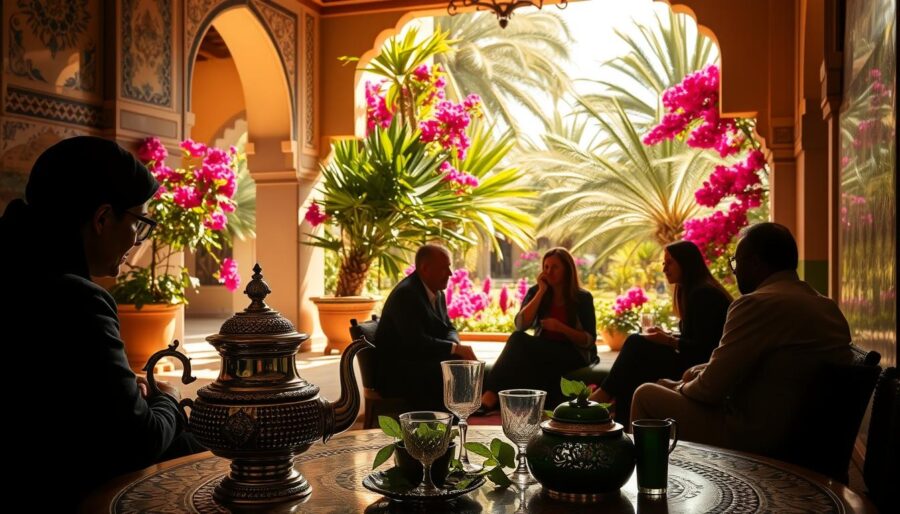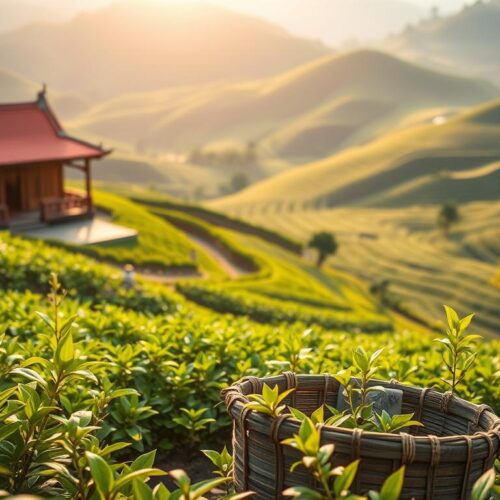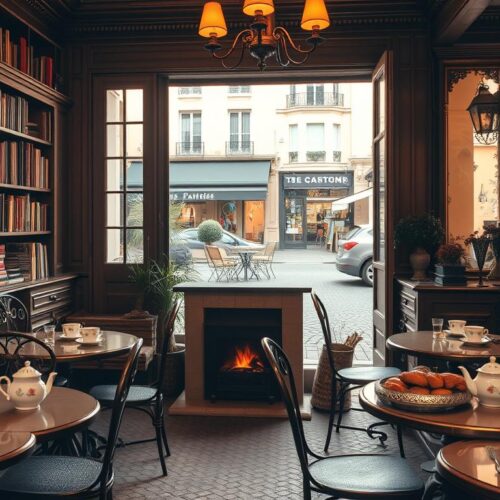Moroccan hospitality shines through its tea culture. The heart of this tradition is Moroccan mint tea. It’s not just a drink, but also a sign of warmth and friendship. This guide will show you the rich tea rituals. You’ll learn about the flavors and history that make these moments so important. We’ll cover everything from key ingredients to how to make the tea properly.
Let’s go deeper into these tea customs. We’ll see why hospitality is key in making each cup special.
Overview of Moroccan Tea Culture
Moroccan tea culture is more than enjoying a drink; it’s about hospitality and togetherness. When people offer tea in homes or markets, it shows warmth to guests. This tradition is important in Moroccan life, highlighting connections in the community. Serving tea connects different generations and marks special events and everyday moments.
Tea first came to Morocco in the late 18th century from China. This started Morocco’s unique tea traditions. When Moroccans prepare and serve mint tea with sweets, it shows their culture and the art of their ritual.
Learning about Moroccan tea helps you appreciate their tea customs. Drinking tea in Morocco tells the stories of how cultures met and mixed there over time. You’ll see how tea brings people together, creating shared moments and memories.
The Ingredients of Moroccan Mint Tea
To truly enjoy Moroccan mint tea, you must know its key ingredients. They are Chinese green tea, fresh mint leaves, and sugar. Each element plays a crucial part in giving the tea its unique taste and smell.
Chinese green tea is the base, adding depth that goes well with the lively mint. Mint leaves bring a cool, aromatic touch. With sugar, you can adjust the sweetness to suit your taste.
These ingredients together capture the essence of Moroccan tradition. The mix of flavors makes this drink more than just tasty. It’s also a symbol of warmth and welcoming in Moroccan culture.
The Moroccan Tea Preparation Process
Moroccan tea making is an art that values each step. It begins with a hot water rinse of the green tea leaves. This removes any bitterness for a smoother taste. Then, the leaves soak in boiling water to release their rich smells.
Adding fresh mint and sugar is crucial. It’s not just about taste; it’s about welcoming others warmly. Making tea is also a social event, building connections.
Pouring the tea from above into a glass is special. It makes the taste better and looks impressive. This step shows the host’s skill. It adds a refreshing feel and shows tradition and care.
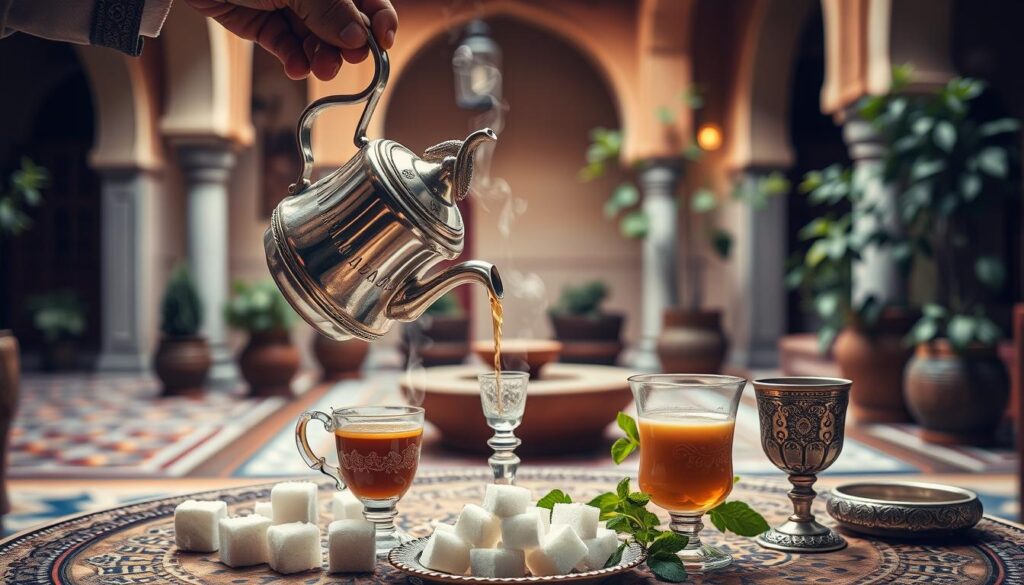
| Step | Description |
|---|---|
| 1. Rinse | Rinse green tea leaves with hot water to reduce bitterness. |
| 2. Steep | Steep the rinsed tea leaves in boiling water for optimal flavor. |
| 3. Add Ingredients | Add fresh mint and sugar to enhance flavor and aroma. |
| 4. Aerate | Pour from a height to aerate the tea and improve its texture. |
The Importance of Hospitality in Moroccan Tea Culture
In Morocco, hospitality shines bright in their tea culture. It shapes how people connect in social settings. Inviting someone over for tea is a way of showing respect and appreciation. It makes guests feel welcome, opening the door to deep conversations and connections. This ritual is a big part of Moroccan life, showing how tea brings people together.
At family gatherings, sharing stories with a cup of mint tea is common. In business meetings or collaborations, tea helps build bridges. It fosters strong relationships and understanding between people. Participating in these tea rituals honors Morocco’s traditions. It also strengthens the ties you have with others.
Different Variations of Moroccan Tea
Moroccan mint tea is well-known, but there are many other types too. They show the rich culture of the country. Each area has its own tea blends and ingredients, offering unique flavors and experiences.
In some places, you’ll find special green teas, not just the usual gunpowder variety. They might add herbs like thyme or sage, bringing a new twist to the mint taste. Also, spices like cinnamon or anise can be used, making the tea even more special.
People differ in how sweet they like their tea. Some love lots of sugar, while others prefer just a little. Honey is also popular, adding richness to the tea’s natural flavors.
These Moroccan tea varieties show the different tastes across Morocco. Each version has its own appeal, inviting you to try the wide range of flavors in this traditional drink.
The Symbolism of Tea in Moroccan Traditions
In Moroccan culture, tea is more than just a drink. It symbolizes hospitality and strengthens bonds among family and friends. By joining the tea ritual, you dive into a tradition filled with meaning. It mirrors the core of Moroccan life.
Moroccan mint tea tastes sweet, celebrating life’s joyful moments. Every sip is a tale of gathering and joy. Yet, its slight bitterness reminds us of life’s tough times. It symbolizes the ups and downs we face, adding depth to the Moroccan experience.
Making tea in Morocco is an art. Pouring it from up high to make it froth shows care and dedication. This process reflects how relationships are built with patience and love. Tea represents not just a beverage, but shared stories and collective identity.
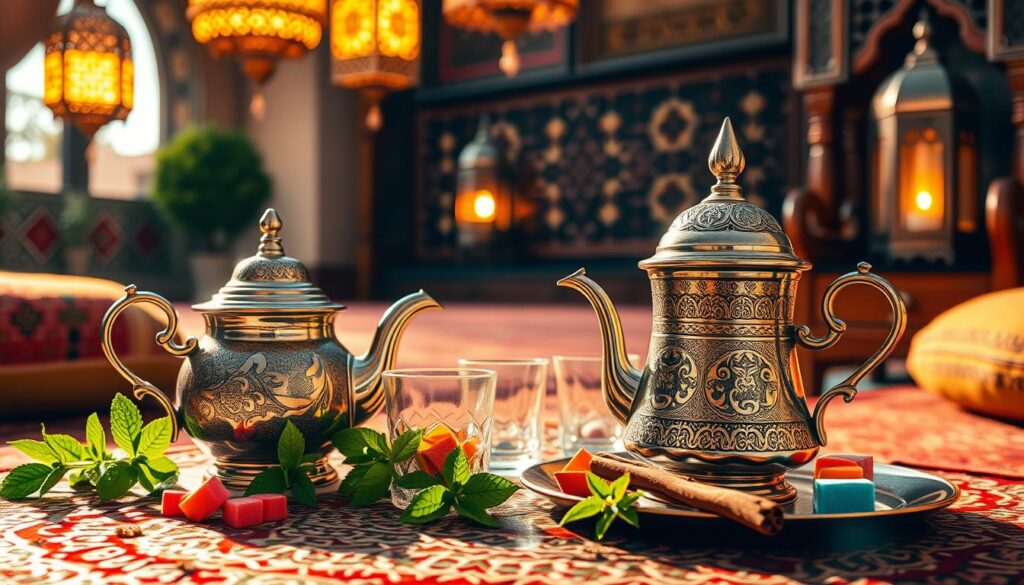
Moroccan tea traditions are deep with meanings that touch everyone. The symbolism of tea connects people, offering time for reflection, talks, and unity.
The Role of Tea Houses in Moroccan Life
Tea houses are very important in Morocco. They are where people meet to enjoy tea and make friends. These places buzz with joy and chatter. They are more than spots to drink tea; they unite communities.
In busy cities, tea houses bring Morocco’s culture to life for both locals and tourists. You can try traditional teas and snacks there. They’re places where young and old share tales and opinions. Tea houses help connect people from all walks of life.
Tea houses mean a lot to Moroccans. They’re the heart of the nation’s hospitality and social scenes. So, they’re key cultural spots in Morocco.
Tea and Food Pairings in Moroccan Culture
In Moroccan culture, tea is more than just a drink. It goes hand in hand with various foods to enhance eating moments. Favorites include traditional snacks and sweets. Baklava and almond briouats highlight the sweetness of Moroccan mint tea, making a perfect match.
Tea also pairs well with savory dishes like tagines. The bold spices in Moroccan meals contrast nicely with the cool mint tea. This combination boosts the flavors, making each bite more delightful.
Exploring these food pairings deepens the appreciation for Moroccan tea rituals. At gatherings, sharing Moroccan mint tea and snacks shows the country’s warm hospitality. By trying these combinations, you get a closer look into Morocco’s rich culinary traditions.
| Food Pairing | Description |
|---|---|
| Baklava | A sweet pastry made of layers of filo filled with nuts and honey. |
| Almond Briouats | Fried or baked pastries filled with almond paste, often dipped in honey. |
| Tagines | A flavorful stew cooked in a traditional earthenware pot, often featuring rich spices. |
| Nuts | A selection of roasted and salted nuts, providing a crunchy contrast to the tea. |
Tips for Enjoying Moroccan Tea at Home
To experience Moroccan tea at home, start with quality green tea and fresh mint. These are essential for an authentic taste. The art of making perfect tea involves pouring it from above. This technique enhances its flavor.
Setting the right mood is important too. Light some candles and play soothing music for a Moroccan tea house feel. Enjoy your tea with treats like baklava or simple nuts and dried fruits. This makes the tea experience better.
Try making tea rituals a part of your life. Invite friends or family to share in the process. This not only brings you closer but also teaches the importance of Moroccan tea tradition. Embrace these practices to fully enjoy the beauty of Moroccan tea culture.
The Global Influence of Moroccan Tea Culture
Moroccan tea culture is now famous worldwide, making tea lovers everywhere happy. Its unique way of making mint tea, with skillful pouring and bold flavors, has won many hearts. Now, cafes and restaurants around the globe offer Moroccan tea, sharing its special taste and traditions with others.
This tea-serving ritual shows how welcoming the Moroccan culture is and how it brings people together. In big cities like New York, Paris, and Tokyo, anyone can enjoy this fragrant tea. This shows how something as simple as tea can connect different cultures and traditions worldwide.
Conclusion: Embracing Moroccan Tea Traditions
Moroccan tea traditions offer a special look into a culture that values hospitality, connection, and talking. These rituals are a key part of Moroccan life, showing the importance of community and family. Taking part in these tea rituals is a way to respect a long-standing tradition that’s about more than just drinking tea.
Enjoying mint tea with people you know or even someone new is not just having a drink. It’s about being part of a social event that builds and strengthens relationships. This tradition highlights the power of simple actions to show kindness and open hearts.
Learning about Moroccan tea lets you join a worldwide story that appreciates the charm of different cultures coming together. Every sip can take you to places like Marrakech or a quiet spot in the desert, making connections that go beyond countries. Dive into these traditions with passion, and allow the warm experience of Moroccan tea rituals to fill your life with joy.

